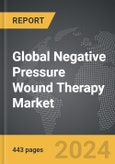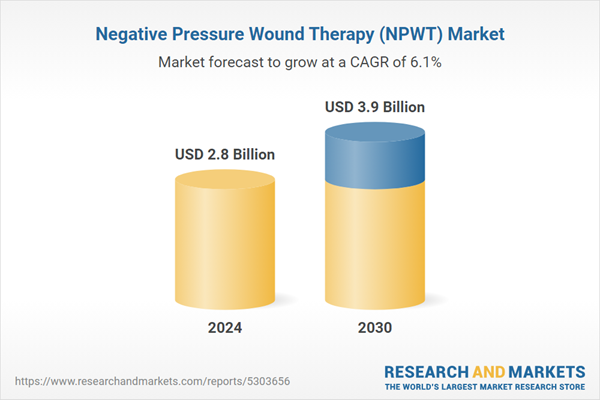The global market for Negative Pressure Wound Therapy (NPWT) was valued at US$2.8 Billion in 2024 and is projected to reach US$3.9 Billion by 2030, growing at a CAGR of 6.1% from 2024 to 2030. This comprehensive report provides an in-depth analysis of market trends, drivers, and forecasts, helping you make informed business decisions. The report includes the most recent global tariff developments and how they impact the Negative Pressure Wound Therapy (NPWT) market.
Technological advancements have significantly enhanced the effectiveness and usability of NPWT systems. Modern NPWT devices are more compact, portable, and user-friendly, allowing patients to continue their therapy at home, thereby reducing hospital stays and healthcare costs. Innovations such as disposable NPWT systems have provided cost-effective solutions for wound care, particularly in outpatient settings. The development of advanced dressings that incorporate antimicrobial agents and provide better sealing has improved the safety and efficacy of NPWT. Additionally, smart NPWT devices equipped with sensors and connectivity features enable remote monitoring of wound healing progress, providing real-time data to healthcare providers and facilitating timely interventions. These technological advancements have expanded the applications of NPWT, making it a standard practice in wound management.
The growth in the NPWT market is driven by several factors, including the increasing prevalence of chronic wounds, rising awareness of advanced wound care therapies, and advancements in NPWT technology. The global rise in conditions such as diabetes and obesity, which are associated with a higher incidence of chronic wounds, has significantly boosted the demand for effective wound care solutions like NPWT. Increased awareness among healthcare providers and patients about the benefits of advanced wound care therapies has further propelled market growth. Technological advancements, such as the development of portable and disposable NPWT systems, have made this therapy more accessible and convenient, encouraging broader adoption. Additionally, the growing focus on improving patient outcomes and reducing healthcare costs has led to the increased use of NPWT in both hospital and home care settings. Government initiatives and reimbursement policies supporting advanced wound care therapies are also contributing to the market's expansion.
Segments: Product (Conventional, Single-Use); Wound Type (Chronic, Acute); End-Use (Hospitals, Home Care Settings, Other End-Uses).
Geographic Regions/Countries: World; USA; Canada; Japan; China; Europe; France; Germany; Italy; UK; Spain; Russia; Rest of Europe; Asia-Pacific; Australia; India; South Korea; Rest of Asia-Pacific; Latin America; Argentina; Brazil; Mexico; Rest of Latin America; Middle East; Iran; Israel; Saudi Arabia; UAE; Rest of Middle East; Africa.
The analysts continuously track trade developments worldwide, drawing insights from leading global economists and over 200 industry and policy institutions, including think tanks, trade organizations, and national economic advisory bodies. This intelligence is integrated into forecasting models to provide timely, data-driven analysis of emerging risks and opportunities.
Global Negative Pressure Wound Therapy (NPWT) Market - Key Trends & Drivers Summarized
Negative Pressure Wound Therapy (NPWT) is an advanced wound care technique used to promote healing in acute and chronic wounds by applying continuous or intermittent negative pressure to the wound bed. This therapy involves the use of a sealed dressing connected to a vacuum pump, which creates a negative pressure environment. The negative pressure helps to remove exudates, reduce edema, promote granulation tissue formation, and enhance blood flow to the wound area. NPWT is widely used in the treatment of complex wounds, including diabetic ulcers, pressure ulcers, traumatic wounds, and surgical wounds. This therapy has been proven to accelerate healing, reduce the risk of infection, and improve overall patient outcomes, making it a vital tool in modern wound care management.Technological advancements have significantly enhanced the effectiveness and usability of NPWT systems. Modern NPWT devices are more compact, portable, and user-friendly, allowing patients to continue their therapy at home, thereby reducing hospital stays and healthcare costs. Innovations such as disposable NPWT systems have provided cost-effective solutions for wound care, particularly in outpatient settings. The development of advanced dressings that incorporate antimicrobial agents and provide better sealing has improved the safety and efficacy of NPWT. Additionally, smart NPWT devices equipped with sensors and connectivity features enable remote monitoring of wound healing progress, providing real-time data to healthcare providers and facilitating timely interventions. These technological advancements have expanded the applications of NPWT, making it a standard practice in wound management.
The growth in the NPWT market is driven by several factors, including the increasing prevalence of chronic wounds, rising awareness of advanced wound care therapies, and advancements in NPWT technology. The global rise in conditions such as diabetes and obesity, which are associated with a higher incidence of chronic wounds, has significantly boosted the demand for effective wound care solutions like NPWT. Increased awareness among healthcare providers and patients about the benefits of advanced wound care therapies has further propelled market growth. Technological advancements, such as the development of portable and disposable NPWT systems, have made this therapy more accessible and convenient, encouraging broader adoption. Additionally, the growing focus on improving patient outcomes and reducing healthcare costs has led to the increased use of NPWT in both hospital and home care settings. Government initiatives and reimbursement policies supporting advanced wound care therapies are also contributing to the market's expansion.
Report Scope
The report analyzes the Negative Pressure Wound Therapy (NPWT) market, presented in terms of units. The analysis covers the key segments and geographic regions outlined below.Segments: Product (Conventional, Single-Use); Wound Type (Chronic, Acute); End-Use (Hospitals, Home Care Settings, Other End-Uses).
Geographic Regions/Countries: World; USA; Canada; Japan; China; Europe; France; Germany; Italy; UK; Spain; Russia; Rest of Europe; Asia-Pacific; Australia; India; South Korea; Rest of Asia-Pacific; Latin America; Argentina; Brazil; Mexico; Rest of Latin America; Middle East; Iran; Israel; Saudi Arabia; UAE; Rest of Middle East; Africa.
Key Insights:
- Market Growth: Understand the significant growth trajectory of the Conventional segment, which is expected to reach US$2.7 Billion by 2030 with a CAGR of a 5.7%. The Single-Use segment is also set to grow at 7.2% CAGR over the analysis period.
- Regional Analysis: Gain insights into the U.S. market, valued at $1.4 Billion in 2024, and China, forecasted to grow at an impressive 9.5% CAGR to reach $271.8 Million by 2030. Discover growth trends in other key regions, including Japan, Canada, Germany, and the Asia-Pacific.
Why You Should Buy This Report:
- Detailed Market Analysis: Access a thorough analysis of the Global Negative Pressure Wound Therapy (NPWT) Market, covering all major geographic regions and market segments.
- Competitive Insights: Get an overview of the competitive landscape, including the market presence of major players across different geographies.
- Future Trends and Drivers: Understand the key trends and drivers shaping the future of the Global Negative Pressure Wound Therapy (NPWT) Market.
- Actionable Insights: Benefit from actionable insights that can help you identify new revenue opportunities and make strategic business decisions.
Key Questions Answered:
- How is the Global Negative Pressure Wound Therapy (NPWT) Market expected to evolve by 2030?
- What are the main drivers and restraints affecting the market?
- Which market segments will grow the most over the forecast period?
- How will market shares for different regions and segments change by 2030?
- Who are the leading players in the market, and what are their prospects?
Report Features:
- Comprehensive Market Data: Independent analysis of annual sales and market forecasts in US$ Million from 2024 to 2030.
- In-Depth Regional Analysis: Detailed insights into key markets, including the U.S., China, Japan, Canada, Europe, Asia-Pacific, Latin America, Middle East, and Africa.
- Company Profiles: Coverage of players such as Advin Health Care, 3M Company, B. Braun Melsungen AG, Cardinal Health, Inc., Avery Dennison Corporation and more.
- Complimentary Updates: Receive free report updates for one year to keep you informed of the latest market developments.
Some of the 54 companies featured in this Negative Pressure Wound Therapy (NPWT) market report include:
- Advin Health Care
- 3M Company
- B. Braun Melsungen AG
- Cardinal Health, Inc.
- Avery Dennison Corporation
- DeRoyal Industries, Inc.
- Apria Healthcare Group, Inc.
- ATMOS MedizinTechnik GmbH & Co. KG
- Devon Medical Products
- Convatec Group PLC
- Genadyne Biotechnologies, Inc.
- Direct Healthcare Group
- Carilex Medical GmbH
- BenQ Materials Corporation - AnsCare
- HAROMED B.V.
Tariff Impact Analysis: Key Insights for 2025
Global tariff negotiations across 180+ countries are reshaping supply chains, costs, and competitiveness. This report reflects the latest developments as of April 2025 and incorporates forward-looking insights into the market outlook.The analysts continuously track trade developments worldwide, drawing insights from leading global economists and over 200 industry and policy institutions, including think tanks, trade organizations, and national economic advisory bodies. This intelligence is integrated into forecasting models to provide timely, data-driven analysis of emerging risks and opportunities.
What’s Included in This Edition:
- Tariff-adjusted market forecasts by region and segment
- Analysis of cost and supply chain implications by sourcing and trade exposure
- Strategic insights into geographic shifts
Buyers receive a free July 2025 update with:
- Finalized tariff impacts and new trade agreement effects
- Updated projections reflecting global sourcing and cost shifts
- Expanded country-specific coverage across the industry
Table of Contents
I. METHODOLOGYII. EXECUTIVE SUMMARY2. FOCUS ON SELECT PLAYERSIII. MARKET ANALYSISCANADAJAPANCHINAFRANCEGERMANYITALYUNITED KINGDOMSPAINRUSSIAREST OF EUROPEASIA-PACIFICAUSTRALIAINDIASOUTH KOREAREST OF ASIA-PACIFICLATIN AMERICABRAZILMEXICOREST OF LATIN AMERICAMIDDLE EASTAFRICAIV. COMPETITION
1. MARKET OVERVIEW
3. MARKET TRENDS & DRIVERS
4. GLOBAL MARKET PERSPECTIVE
UNITED STATES
EUROPE
Companies Mentioned (Partial List)
A selection of companies mentioned in this report includes, but is not limited to:
- Advin Health Care
- 3M Company
- B. Braun Melsungen AG
- Cardinal Health, Inc.
- Avery Dennison Corporation
- DeRoyal Industries, Inc.
- Apria Healthcare Group, Inc.
- ATMOS MedizinTechnik GmbH & Co. KG
- Devon Medical Products
- Convatec Group PLC
- Genadyne Biotechnologies, Inc.
- Direct Healthcare Group
- Carilex Medical GmbH
- BenQ Materials Corporation - AnsCare
- HAROMED B.V.
Table Information
| Report Attribute | Details |
|---|---|
| No. of Pages | 443 |
| Published | April 2025 |
| Forecast Period | 2024 - 2030 |
| Estimated Market Value ( USD | $ 2.8 Billion |
| Forecasted Market Value ( USD | $ 3.9 Billion |
| Compound Annual Growth Rate | 6.1% |
| Regions Covered | Global |









